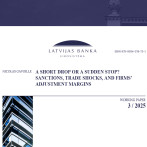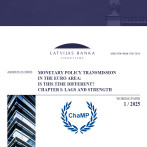How high will interest rates rise in the future?
What are financial markets signalling?

In short
-
The ECB raises interest rates again, but they are still considerably below the level of 2007–2009
-
Market participants expect interest rates to increase further in the near term, so they are likely to approach 3%
-
It is impossible to assess the way interest rates will develop over a longer period of time by just looking at the data from financial market transactions
In September, annual inflation reached 10% in the euro area, while it hit 22.2% in Latvia, substantially exceeding the ECB's medium-term target of 2%. It is clear that the high inflation in the euro area and Latvia is currently being largely driven by the energy crisis and disruptions in the supply chains of goods and raw materials. These issues cannot be dealt with in the short term through the decisions taken by central banks. However, the primary mandate of a central bank is to ensure price stability. Therefore, the European Central Bank (ECB) brings down the curtain on years of highly accommodative monetary policy to curb inflation and raises interest rates.
On 8 September, it increased key interest rates by 75 basis points, which is the largest rise since the establishment of the euro area. By this decision, the ECB joins the continuously growing group of the world's central banks that have taken a decision of this magnitude aimed at reducing the pressure of rising prices.
It is no surprise that many people, after seeing inflation spiral out of control, raise a question – how far interest rates might eventually rise and whether they will also remain high in the foreseeable future? Could they reach the highs needed to reduce inflation during the global financial crisis? To answer this question, we will look at forward or future interest rates used daily not only by monetary policy professionals, but also by Wall Street traders, investment funds and everyone whose profit and professional success depend on the ability to forecast interest rate dynamics as accurately as possible.
The market interest rates such as the commercial banks’ deposit interest rates and EURIBOR rate to which interest payments on mortgage loans and consumer credit are linked closely follow the key interest rates set by the central bank. At the same time, to discuss the future path of key interest rates one should understand the reaction function or the argumentation of the ECB used as a guide by its Governing Council in deciding when and by how much to change them.
The raising of interest rates is the ECB's main tool to reduce inflation and return the economy to a stable price level [1]. Although interest rates have increased over the last months, they remain rather significantly below the highs needed to reduce inflation during the global financial crisis (see Chart 1) when the three-month EURIBOR rate was close to 6%. The current level of interest rates (approximately 1.2%) is historically relatively low. The ECB has quite a long journey ahead towards monetary policy that would be able to successfully contain the pressure of the currently sky-rocketing prices and return inflation to the ECB's medium-term target of 2% (as also admitted by the ECB's President Christine Lagarde at the press conference of 8 September). This surely means only one thing – interest rates will go up in the near term.
Chart 1. Three-month floating interbank interest rate (EURIBOR)
Source: Bloomberg.
Moreover, one can assert with great certainty that the ECB will not stop raising interest rates until it has convincing evidence that inflation has started to show signs of retreating or such a turn is very likely to be seen in the near future. In other words, the ECB's decision as to when to slow down or stop increasing rates will be data driven or depend on the latest macroeconomic data before the meetings of the ECB Governing Council.
Surely, the latest macroeconomic data may even surprise experienced analysts; however, it does not mean that all interest rate forecasts are erroneous and that it is not worth trying to guess their future path. In reality, it is always possible to find out the views of financial market participants about future interest rates. Experienced market participants know how central banks react to macroeconomic statistics news; therefore, they link their forecasts about developments in real economy – in labour and commodity markets – with the future interest rate development scenario which in their view would be preferred by the central bank in such circumstances [2].
Financial market expectations of future interest rates can be indirectly derived from the information included in the terms and conditions and the prices of financial instruments. When engaging in different types of transactions (e.g. those conducted for the purpose of hedging risks or for speculative purposes), financial market participants "reveal cards" and actually share with us their views on future interest rates [3]. They seem to have both heard and believed the ECB's determined and belligerent stance and, as put in economists' language, hawkish [4] message about its readiness to raise interest rates to tame inflation, even if it is to some extent at the expense of economic growth. The three-month EURIBOR rate is expected to reach 3% already in March 2023 (just three months earlier it was anticipated to stand at 1.5% in March 2023). Unlike the situation seen at the beginning of the year, this is a significant leap that will lead to an increase in household and business interest payments on loans with a floating reference rate.
However, market participants are uncertain whether interest rates will remain so high for an extended period of time and expect interest rate hikes to end already in the spring of the next year, with interest rates even starting to decrease. This might be on account of the possible recession. Under such a scenario, the shock caused by the energy crisis will weaken demand that, along with the base effect (prices will be already compared with the elevated level of 2022), will lead to low inflation; in such a situation, the ECB will want to implement a more accommodative monetary policy. It seems that market participants currently believe in such an outcome despite the fact that the ECB's macroeconomic projections for September do not signal this. However, it does not exclude the possibility that the circumstances may change and hence also the market expectations.
Chart 2 Three-month EURIBOR forward rates
Source: Refinitiv, authors' estimates.
Note. The three-month EURIBOR forward interest rates have been derived from forwards and interest rate swaps. Certain missing values have been replaced by a linear interpolation.
It should be kept in mind that market participants are only very rarely able to predict the future precisely, with the historical forward interest rates, only in some cases, coinciding with the actual interest rates (Chart 2). No one has a crystal ball that would allow to predict with a high degree of accuracy the macroeconomic situation several months ahead, especially in current circumstances .
Undoubtedly, the information provided by financial markets is useful as a reference point for raising awareness of the possible future path of interest rates. However, the volatility of expectations is a far too serious obstacle to be ignored when forecasting the medium-term rates. The approach allowing to explain the development of interest rates from another point of view based on stronger economic regularities is related to the equilibrium or the natural interest rate. This is the rate at which the economy is in equilibrium – neither above its potential output level that indicates overheating and high inflation nor below it that would mean non-increasing wages and inflation close to zero or even deflation. More detailed information on the natural interest rate – what it is and how it enables understanding of the longer-term dynamics of interest rates – will be provided in the next article.
[1] Undoubtedly, higher interest rates weigh on the economy over the short term. However, higher inflation "eats up” household savings, raises uncertainty about future prices and forces businesses to reduce investment. Thus, elevated inflation leads to a larger fall in welfare over the medium to longer term; therefore, it must be combated by raising interest rates.
[2] The war in Ukraine, the energy crisis, further possible Covid-19 outbreaks and other geopolitical tensions have brought a row of unknowns to the usual equation of the forecasting arithmetic. To make things more complicated, it is hard to assess the impact of these unpredictable shocks on the economy. For how long will the impact of these shocks last, will the consequences turn out to be long lasting, which sectors will be affected most and what level of interest rate would be appropriate for the given situation? It is complicated to provide an accurate assessment of the future development of the situation in such circumstances.
[3] The reason why financial market participants’ views about the expected interest rates are noteworthy can be found in the theory about the efficiency of the capital market providing that financial market participants in their decisions and transactions take into account all the information available to them at the particular moment. It follows that if the available information does not change over time, the future interest rates reflected in the financial markets will also materialise.
[4] The decision makers who advocate a tighter monetary policy stance to control inflation are called “hawks”, while the advocates of a looser monetary policy stance are called “doves” by those observing and analysing the decisions taken by the Governing Council of the ECB and other central banks.
Textual error
«… …»





